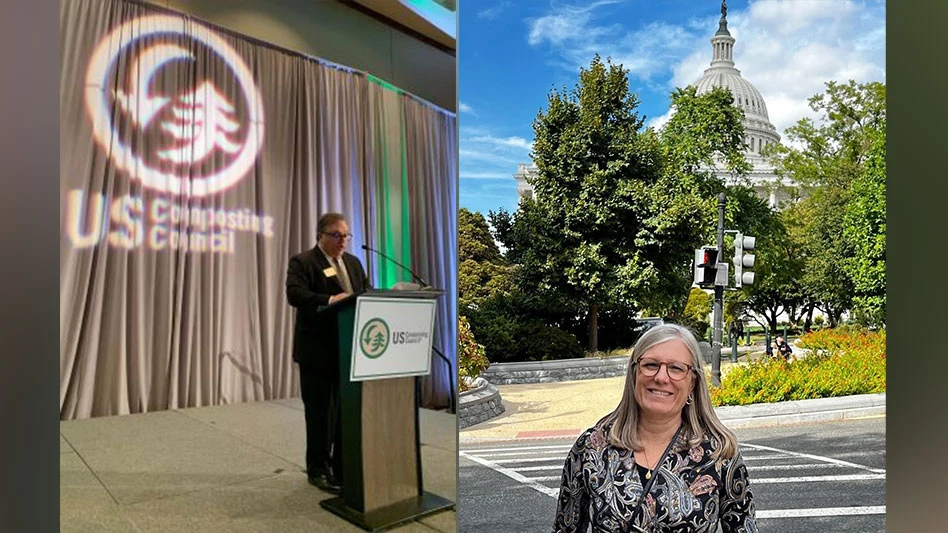
Megan Smalley
Brand owners, recyclers and other plastics recycling industry stakeholders are set on collaborating to improve recycling for plastics packaging, but these stakeholders also see several obstacles to achieving that collaboration. During the Plastics Recycling World Expo Nov. 3, which took place in Cleveland, panelists in a session titled “Confronting the plastics packaging challenge head-on: can solutions be found through industrywide collaboration” shared what they thought to be the greatest challenges and opportunities for recycling plastic packaging in the next few years.
The challenges
Jeremy DeBenedictis, president of Akron, Ohio-based Alterra Energy, said complicated messaging to consumers about what packaging can and cannot be recycled is too confusing today.
“There seems to be very complicated and different messaging to consumers,” he said, adding that today’s consumers tend to care more about recycling and sustainability.
Legislation surrounding sustainability also is challenging, with different regulations emerging in different parts of the country. Susan Graff, vice president and principal of global corporate sustainability at Ann Arbor, Michigan-based Resource Recycling Systems (RRS), said she’s doubtful the U.S. will develop national recycling legislation “anytime real soon.”
“Even if it happened tomorrow, it would take four years to implement,” Graff said. She added that the industry wants to see sustainability solutions sooner than that, suggesting that large consumer brands and retailers will likely be the ones to shape supply chain and waste management changes rather than national policy. “Brand owners and retailers have an opportunity to work in partnership with the recycling supply chain and make sure that that supply chain can robustly service the needs that they have.”
Tamsin Ettefagh, chief sustainability officer at Orlando, Florida-based PureCycle Technologies, shared a similar opinion during the panel discussion. “I think circularity is really the impetus where consumer brands have to play,” she said.
Ettefagh also said she sees municipalities and converters contact with material recovery facilities (MRFs) but not with recyclers. “Without contracts, how do you borrow money for investment? Without guaranteeing supply, it’s difficult for industry to invest in quality.”
The opportunities
Despite the challenges stakeholders see related to recycling, panelists were optimistic about potential collaboration among brands, retailers and recyclers.
Graff of RRS said there have already been successful examples of collaboration. She referenced the Materials Recovery For the Future (MRFF) pilot project she worked on as a research director as being one such success story, adding that Amcor was involved with the project. Graff said the project demonstrated that flexible plastic packaging can be collected, sorted and baled at MRFs through curbside recycling programs.
“That was one great example where brand owners, retailers, converters and the MRF came together to show how we could get this material into a stream and into end market products,” she said.
David Clark, vice president of sustainability at Switzerland-based Amcor, added that collaboration among stakeholders is key but that the industry should not think about it so much as a circle where packaging is always transformed back into the same product again but rather as a web.
“Everyone likes to think of the supply chain as a circle. It’s not a chain or a circle, it’s a web,” he said. “Everything changes hands. And webs are much more resilient than chains. If we start thinking about it that way, it brings some different solutions to bear.”
Clark also said he is optimistic about recyclable packaging solutions emerging today. He said there are more consumer packaged goods companies designing for recyclability. “Up until two years ago, recyclability was not part of design criteria.”
Alterra’s DeBenedictis said he’s optimistic about future opportunities with advanced recycling. While he thinks mechanical recycling remains important, he said advanced recycling can augment traditional recycling. “We need all of these solutions to get us to the next level.”
DeBenedictis said Alterra Energy’s Akron facility recycles 50 tons per day of flexible packaging materials. He added that chemical recycling is in its “infancy” but that he is hopeful to see improvements to the technology in the next five years that will make it more reliable and repeatable.
Although communication to consumers needs improvement, Vytas Gruodis, co-founder of U.K.-based Prevented Ocean Plastic, said today’s consumers care more about recycling and diverting ocean-bound plastics. He said he hopes that excitement will provide more opportunities for brands and retailers to effectively communicate with consumers on recycling plastic packaging. “Finding new messages to excite consumers is one way to get better results,” he said.
Latest from Waste Today
- EPA takes steps to require MSW incinerators to report toxic chemical emissions
- Food waste composting system coming to Canadian province next year
- Updated: CAA submits final draft program plan in Oregon
- Enviri names new president of Harsco Environmental business
- Bureau of Labor: Fatality rate increased for waste collection in 2023
- Atlanta awarded $3.2M to support electric vehicle fleet transition
- McNeilus to spotlight collection innovation at CES 2025
- Baltimore nonprofit opens zero-waste facility





